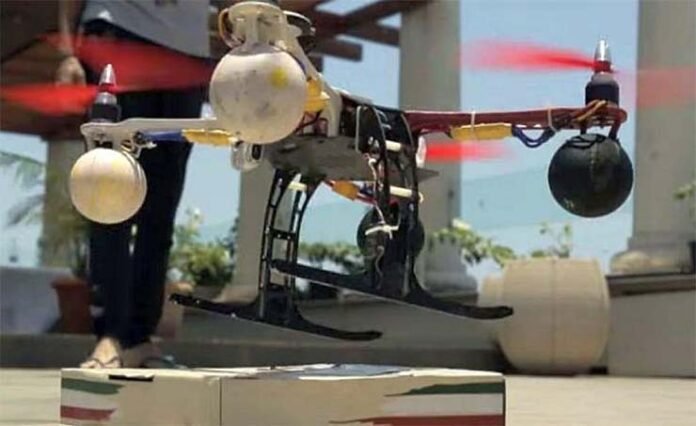New Delhi: In recent years, the fast pace of tech development has put drones at the centre of everyday life. It’s being used for delivery to intelligence gathering and from covert surveillance missions to large-scale assaults. Considering the emerging threats due to swarms of armed drones striking in modern warfare scenario has put drone detection capability in the spotlight.
Taking cue, Unistring Tech Solutions (UTS), the Hyderabad-based indigenous defence R&D company has developed drone detection system AESA (Active Electronic Scanning Array) Radar which is capable of tracking up to 100 targets simultaneously. It also provides robust multi-target tracking capabilities, essential for complex operational scenarios involving numerous UAVs.
UTS, founded by veteran DRDO scientists K Srinivasa Raju and Nagendra Babu Samineni is at the forefront of a mission to redefine the future of electronic warfare and contribute to India’s self-reliance in defence technologies.
The company is fully aligned to indigenising defence technologies and providing crucial solutions to the armed forces, according to UTS managing director, Nagendra B Samineni.
“We dreamt 10 years ago that we should build a company, we should stop importing certain systems to India, and fortunately now we are able to achieve this. Today if you see large part of the anti-drone systems that are being purchased by Indian government, they are all indigenously designed and developed and we are part of the subsystems of the Big Value systems that India has purchased in the name of anti-drone,” he said.
He added that recently, the company has secured a significant contract worth Rs 43.42 crore from Indian public sector undertaking for the supply of advanced electronic warfare (EW) equipment to bolster capabilities of the Indian armed forces.
Samineni said, “We have got this AESA radar contract through iDEX where we will have to deliver this product in the next six to eight months… and this product has also got a lot of requirement because there is a huge minimum orders quantity (MOQ) that has been projected by the users. So this is a really good initiative from the government to encourage the startups… earlier defence procurement cycles used to be very long.”
The AESA radar is equipped with advanced electronic counter-countermeasure (ECCM) features to counteract jamming and other electronic warfare tactics, ensuring reliable performance even in contested environments and `hits the mark’ on all counts.
Optimised for detecting and tracking swarms of drones, a critical capability given the rising threat of coordinated unmanned aerial vehicle (UAV) attacks, the AESA radar’s AI-based classification algorithms reduce false alarms by accurately distinguishing between drones and other objects such as birds.
Though suitable for detecting larger aircraft, the traditional radar systems, have long struggled to provide accurate and timely detection of smaller, agile UAVs. Thus, underlining the need for a specialised solution tailored to counter the unique challenges posed by small drones.
Designed to address the growing threats posed by UAVs, the AESA Radar for counter-drone applications marks a significant advancement in radar technology. It is the result of extensive research and development, validated through rigorous testing, and is recognised for its innovation and effectiveness.
The development of this groundbreaking product, according to the company, came with the motivation to enhance national security, meet user requirements, and drive innovation.
At the recently held 49th ELCINA awards 2023-2024 ceremony, UTS clinched a prestigious industry award. The award was an acknowledgement for UTS’ contribution towards the mission of a self-reliant India at the cutting-edge of electronic warfare.
UTS it received the award for innovation in the small and medium enterprises category. The company sees the prestigious ELCINA (Electronic Industries Association of India) award as a recognition of its commitment towards advancing India’s defence capabilities through innovation and technological excellence.
The global increase in demand for counter-drone technologies, offers strong export opportunities for AESA Radar.
“It will be considered for export…however we will have to go through the government procedures for exports so will have to take the due clearances. We can export these products to friendly countries as designated by the government we can do that,” Samineni said.
UTS, armed with the new order, is poised to further strengthen its position in the defense electronics market.
The company, a leading provider of innovative solutions in the domains of electronic warfare, radar, communication systems, and other advanced technologies, is eyeing a turnover of over Rs 250 crore in the current financial year.
“So this year we have close to Rs 250 plus crore of projects to be executed and this is one among them…we see tremendous growth for the company supported by the foundation we have laid over the last 10 years, the kind of technologies that we have developed are really yielding the benefits,” Samineni said.
Moving ahead, for Unistring Tech Solutions and founders, the mission continues unabated.
Raksha Anirveda's editorial desk team brings in the collective experience of creative professionals - a fine mix of senior copy editors, writers, proofreaders and designers. Working as a team, they continuously create, manage, and curate content to sustain the magazine's profile and reputation in line with market trends and achieve magazine's goal.





